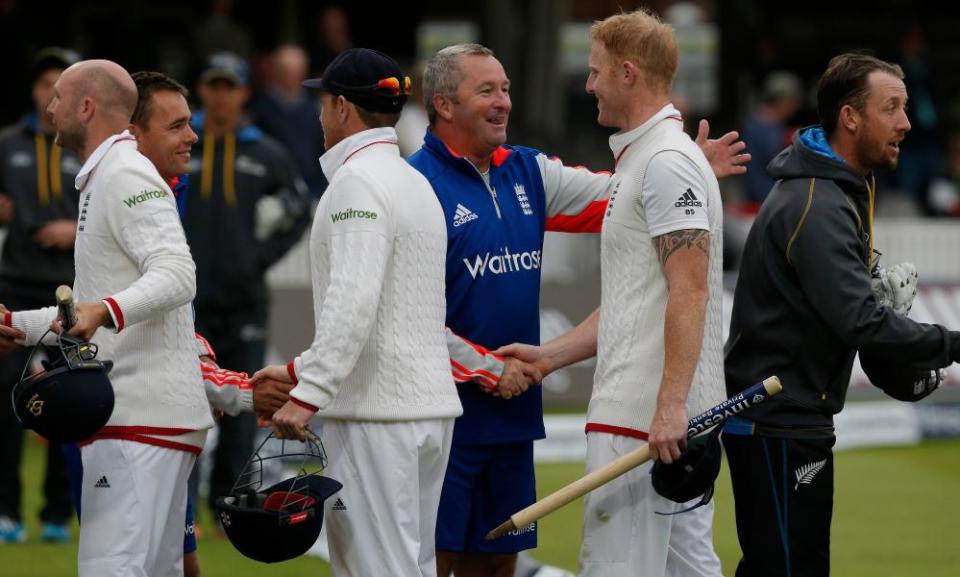Ten years of Ben Stokes: from raw all-rounder to England’s star turn
Scott Borthwick, quite understandably, just wants to land it. He’s 23, a leg-spinner on Test debut, about to bowl his first ball against Australia at the Sydney Cricket Ground, and England are already 4-0 down in the series. It’ll be five shortly. Ben Stokes, 22, a friend and Durham teammate, playing just his fourth Test, wants a little bit more.
“Just before I bowled,” says Borthwick, “he came up to me and said: ‘Whatever happens this ball, I want you to try and spin it as far as you can, as hard as you can. If it bounces twice, make sure it spins. Try and bowl a Gatting ball.’ I just remember thinking: ‘That’s his mindset.’”
Stokes – in a miserable, era-crumbling, Johnson-fearing Ashes campaign for England – took six for 99 on the same day. Earlier on the tour in Perth, where the urn was lost, there had still been space on the canvas for a bit of resistance when he hit his first Test century. “It may be the most significant innings by an England player this decade,” Vic Marks wrote in these pages.
Next month marks both 10 years since that knock – a raw, authoritative fourth-innings 120 on a cracked-open Waca pitch – and Stokes’ Test debut, which had come earlier at Adelaide. He entered a decaying dressing room, where great careers were collapsing. Jonathan Trott had flown home after the first Test, the mental strain of the game having overwhelmed the anchor at No 3. Graeme Swann retired midway through the series and Kevin Pietersen was sacked after the scoreline was sealed at 5-0. As one enormous presence left the room, another entered.

It took some time to figure out what to do with Stokes. He could only find a spot at eight in his first home summer as a Test cricketer, and three innings against India resulted in three ducks. He was shunted down the order in one-day cricket, too, eventually missing out on a place at the 2015 World Cup.
To get to his best, he needed to be at the centre, not consigned to the margins. In the summer of 2015, Paul Farbrace, interim head coach before the appointment of Trevor Bayliss, moved him up to No 6. He responded against New Zealand with an innings-saving 92 and an 85-ball hundred, the fastest in Tests at Lord’s. “My view was that the more responsibility you gave him, the more you got out of Ben,” says Farbrace. “It was a pretty simple decision, I felt, to put him at six and basically say to him: ‘You’re our all-rounder. You’re the bloke we’re backing.’”
Farbrace, England’s assistant coach from 2014 to 2019, wanted Stokes liberated elsewhere, too. “I’ve always told him to field where he thinks the ball’s going to go. Whether it’s slip, backward point, long-on, deep extra cover – use your instincts. Don’t worry about the captain, just tell the player: ‘Move, I’m coming in here.’ The more central to the game he was, the more you got out of him.”
Talk of Stokes and it always comes down to moments: heartbreak at Eden Gardens, a brawl in Bristol, saviour at Lord’s, genius at Headingley, glory at the MCG. But after a settling-in period, the red-ball numbers turned good, too. From the start of 2016 to the end of 2020, 47 Tests resulted in eight hundreds and 112 wickets; a batting average over 40, a bowling one under 30.
His 2021 was a well-documented struggle, with time taken out to look after his mental health. Since his return, it’s all been about his leadership: 13 wins as captain and a new word in the dictionary. Farbrace recalls laughter among the press seven years ago on a tour of Bangladesh when Bayliss mentioned Stokes as a future captaincy option. “At that point Ben was seen as a bit of a lad who was fiery on the field, he was aggressive in terms of the way he played his cricket and he wouldn’t necessarily have looked like an England cricket captain from the outside.” Those on the inside – Bayliss, Farbrace and the decision-makers who followed – saw it differently.
His status as all-rounder has taken a hit in the last year due to a troubling knee, leading to the regular sight of a hobble when he bats. But he still commands the centre of English cricket. Who else could quit a format in protest against a packed schedule, and then be gratefully accepted back a year later on the eve of a World Cup? Hindsight suggests that Stokes should’ve probably been ordered to stay at home and sort his knee out for the upcoming Tests against India, but his allure as a player was too much and the English game is beholden to him. He can even turn down a three-year central contract in the knowledge that something better might be on offer down the line.
What’s left for him? He’s won both white-ball World Cups, and only Sir Garfield Sobers and Jacques Kallis have both more Test runs and wickets than him. But it feels like something’s still missing. A World Test Championship would do just fine. Victory in India, where no tourists have won a Test series since 2012, would be magnificent. But it’s an odd quirk that he has just one Ashes triumph, the 2015 series in which he was a supporting act rather than the star turn. Success on the next tour of Australia, 12 years on from where it all began, would top everything.
• This is an extract from the Guardian’s weekly cricket email, The Spin. To subscribe, just visit this page and follow the instructions.

 Yahoo Sport
Yahoo Sport 






































